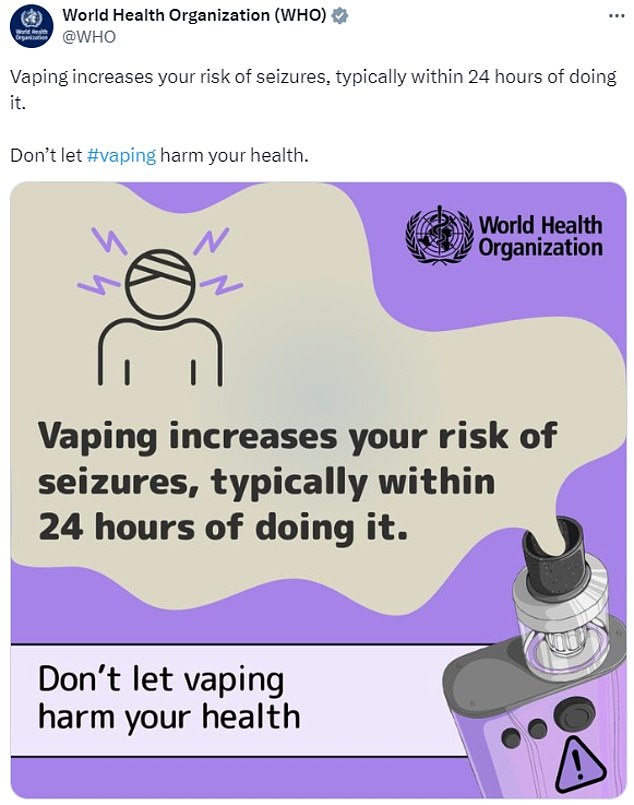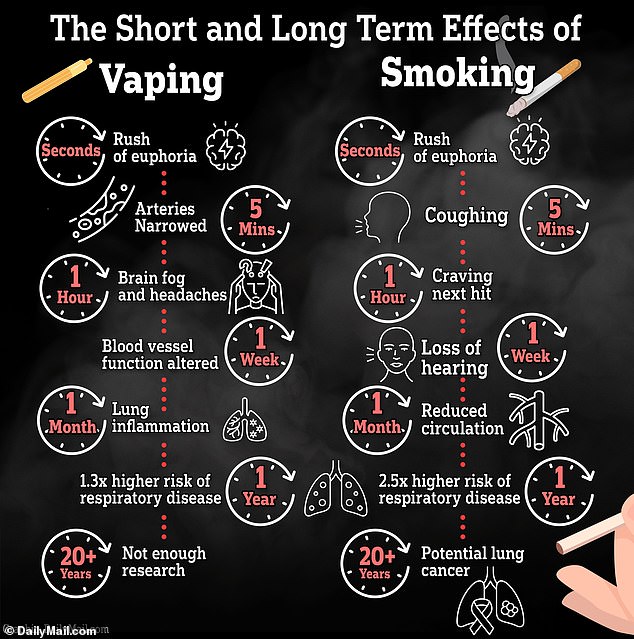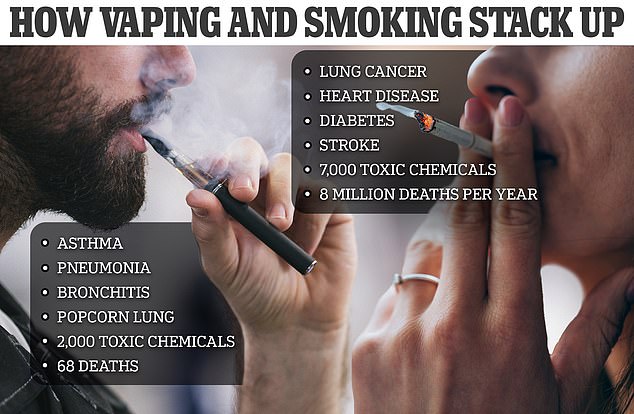The World Health Organization came under fire last night for claiming that vaping can cause a seizure within hours.
Users fact-checked the global health agency on X, prompting the social platform to post a community note.
The note said: ‘This publication is based on inconclusive evidence using studies that have not been peer-reviewed.
“The claim is based on approximately 120 incidents that have occurred since 2019 with an inconclusive outcome.”

The World Health Organization posted the above tweet on Monday.


X Community Notes quickly added that users had questioned the claim in the WHO tweet.
Dr. Charles Gardner, a Brooklyn-based developmental neurobiologist, tweeted: “Please provide peer-reviewed evidence for this claim that vaping causes seizures “typically within 24 hours.”
‘If you can’t do this, delete your tweet. NOTE: I have searched the literature and cannot find any studies that show an increased risk of seizures.’
Steve Rolles, senior policy analyst at the Transform Drug Policy Foundation, a drug policy reform organization, said: “I’m pretty sure this is nonsense. Why is the WHO position on vaping so strangely misaligned?
Other users called the WHO clowns, liars and claimed it was promoting propaganda.
The new wave of criticism comes as the organization is still trying to regain public trust after what many consider a botched WHO response to the Covid pandemic.
It advised against wearing masks for months at the start of the pandemic and numerous scientists have criticized the WHO’s reluctance to acknowledge that Covid was frequently spread through the air and by asymptomatic people.
Additionally, the WHO published a report in 2021 concluding that COVID-19 most likely jumped from animals to humans, ruling out the possibility that it originated in a laboratory, a theory that is being supported. signed by various government agencies.
But the organization backtracked the following year, saying that “key data” was still missing and that it was premature to rule out that Covid could have links to a laboratory.
The community note on X included a link to an editorial about vaping and seizures.
2020 editorial in the Journal of Adolescent Health criticized a 2019 study which analyzed a series of 122 seizures and other neurological symptoms among people who had reported vaping in the previous 24 hours.
The study researchers suggested that because of its proconvulsant effects (meaning it could cause seizures), nicotine could be responsible for the seizures and symptoms.
However, the editorial said the details of the study “raise questions about a causal link, which should be considered when assessing the real health threat of nicotine vaping to youth.”




A study published this week linked vaping to health effects such as asthma, pneumonia and bronchitis. However, smoking has long been associated with serious health consequences, such as lung cancer and heart disease.
He added: “A big question is why inhaled nicotine from e-cigarettes should cause seizures, while nicotine from conventional cigarettes should not.”
The authors said a person would need to inhale a very large dose of nicotine to cause a seizure, but the amount of substance in a vaping device is much smaller compared to that of a traditional cigarette.
Furthermore, the toxic effects of a large intake of nicotine would be expected to occur within minutes of inhalation and resolve within several hours, and the authors said that “seizures appear unlikely to occur without other manifestations of systemic toxicity.”
One shortcoming of the 2019 study, according to the editorial, was that it looked at seizure “events” that were self-reported and not always clear.
Descriptions differed: some reported severe episodes and others detailed tremors or seizure-like activity.
In most cases, the events were not evaluated by medical professionals.
The authors of the editorial noted that nicotine can cause anxiety attacks and involuntary muscle contractions that some people may interpret as seizures even though they are not.
Vaping has been promoted as a safer alternative to cigarettes and is often used as a smoking cessation tool.
However, the devices are not without risks.
A major review earlier this year found that it may increase the risk of eight lung diseases: asthma, chronic obstructive pulmonary disease (COPD), bronchitis, various forms of pneumonia and popcorn lung, or damage to the small airways of lungs.
Smoking traditional cigarettes has long been associated with deadly diseases such as lung cancer, diabetes, heart disease and stroke, for which survival rates are much lower.
Traditional cigarette smoking rates have decreased, while vaping rates have increased, especially among middle and high school students.
A 2023 CDC analysis found that 2.1 million of these children (nearly eight percent of the student body) were using the devices and 47 percent of children who had ever tried an e-cigarette were currently vaping.
Vaporizers typically come in appealing flavors like cotton candy and crème brulee and have packaging that appeals to younger users.
This has hooked millions of young people, and data shows that around 90 percent of them have reported using a fruit or candy-flavored product.
